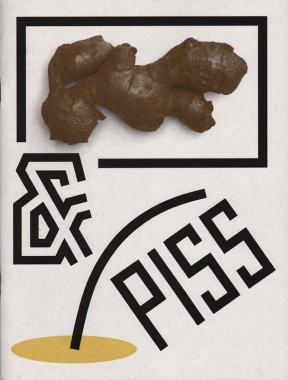
Ginger&Piss 1, Loud
Softcover, 22 pp., offset 4/1, 210 x 275 mm
Edition of 200
ISBN 978-94-90629-03-8
Published by Kunstverein
$21.00 ·
Dear Reader,
Ginger&Piss is Kunstverein’s in-house magazine — a cross between an academic journal and a darts club newsletter. Ginger&Piss (the name a misquotation of Lawrence Weiner) is published twice yearly, with the first edition appearing in a short run. Each issue contains a maximum of five or six contributions of varying length, appropriate to the individual subject matter.
The remit of Ginger&Piss is simple: to offer an outlet for authors to say what they feel is vital (and not necessarily at all related to the art world) but were unable, unwilling or too afraid to publish previously. The concept dictates that each contributor writes under a pseudonym. We — the editors — guarantee full anonymity.
Loud is the subject of the first issue and it is a broad — probably far too broad — theme (if a them at all). In fact Quiet might have been more appropriate. But we at Ginger&Piss think a clear, ‘honest’ voice is better suggested by volume than whispering.
— Krist Gruijthuijsen and Maxine Kopsa
Anonymous, Art, Billy Male, Distribution, Elvira Belafonte, G. Alonso Oeuf, Ginger&Piss, Hula Capellinni, Krist Gruijthuijsen, Kunstverein, Marc Hollenstein, Maxine Kopsa, T. Gidley, The Mondrian Foundation
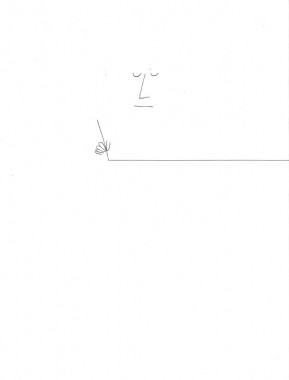
Saul Steinberg, The Line
Leporello Foldout, 30 pp., offset 1/1, 195 x 255 mm [5850 x 255 mm unfolded]
Edition of 1000
ISBN 978-3-905714-80-7
Published by Nieves
$24.00 · out of stock
The hallmark of Saul Steinberg’s art is the inked line, always drawn with a spare elegance that expresses the semiotic richness of the line itself. As it shifts meaning from one passage to the next, Steinberg’s line comments on its own transformative nature.
The Line, the original a 10-meter-long drawing with 29 panels that unfold, accordion fashion, is Steinberg’s manifesto about the conceptual possibilities of the line and the artist who gives them life. His drawing hand begins and ends the sequence, as the simple horizontal line that hand creates metamorphoses into, among other things, a water line, laundry line, railroad track, sidewalk, arithmetic division line, or table edge; near the end, the curlicues etched by the iceskater’s blade remind us of the role calligraphy plays in Steinberg’s art.
The Line was designed for the Children’s Labyrinth, a spiraling, trefoil wall structure at 10th Triennial of Milan, a design and architecture fair that opened in August 1954. The drawing, photographically enlarged and incised into the wall, was one of four Steinberg conceptions used on the labyrinth.
Art, Artists Rights Society, Distribution, Illustration, Nieves, Saul Steinberg, The Saul Steinberg Foundation
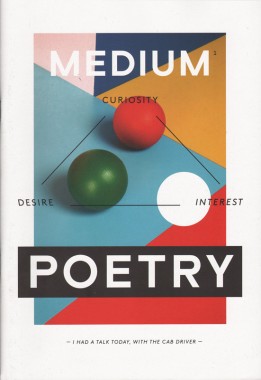
Medium 1, Poetry
Softcover, 64 pp., offset 4/4, 165 x 240 mm
Edition of 500
Published by Nieves
$14.00 · out of stock
Today there was a guy leaning the wrong way in the tube. It was not immediately noticeable. There was no one else sitting nearby. No other passengers to compare him to. But then I did notice that every time the carriage came to a stop, he leaned away from the direction we were moving. Very slightly. Think about it. You’re supposed to lean forward. In the direction you were moving toward. Toward the point which the weight of your body was expecting to reach. Now this guy, he leans the other way. Just slightly. As a friend of mine would put it, he has a great sense of irony. Definitely. That’s important in life. They say that Rothko, he killed himself because he met the people who bought his art. No sense of irony. Me neither I don’t have any sense of irony. I like to take things at face value. Your wife she once told me that what led to the demise of the Black Panthers, aside from the absence of trust, and a murderous governmental incarceration campaign, it was their complete lack of a sense of humor. It was only much later that I realized she meant a murderous governmental incarceration campaign is actually a lot worse than not having a sense of humor. But these ironies are lost on me. Your sister and your wife they both say so. When I tell them things I find funny, they rarely laugh. I’m not even going to mention this guy in the tube to them. I recently told them about my bathroom sink in this hotel room. Real bad design. Flat. Which meant the liquid always accumulated in the corners. Instead of flowing down the drain. You had to use your fingertips to fish out the shaved hair stubble from the corners of the sink. Or it would just lie there. Waiting. You know what’s even funnier: you had to try and propel what you spat out when you brushed your teeth towards the center of the sink. Or you’d have mounds of mucus and toothpaste. Just drying in small heaps, here and there. Hilarious. And speaking of heaps of mucus. Another thing I’ll keep to myself – this was the funniest thing in years: I saw an old couple smooching in the street the other day. How often do you see that. Teenagers, yes. Or oldies arm in arm. But here you had oldies with their tongues down each other’s throats. Right there in the pedestrian zone. Eighty years old maybe more. Couldn’t believe it. I just stood there laughing. These oldies have no sense of humor either. They pretended not to hear me. But I could tell they heard me perfectly well. So now the carriage starts moving again, and I stand up, knowing I’ll exit at the next station. You see there are things I’m less sure about. Are they funny or just poetic. Lately my eyeballs scrunch as I close my eyes. A crunching sound. Brief, almost imperceptible. The sound is a bit like high-tech mechanics when they start aging. Wearing out. A whispering scrunching sound. Funny, or lyrical? Now as I exit the carriage, I notice there’s vapor in the air as I breathe, despite the high temperatures. It’s been like this all week. Again, very odd and almost funny. In a tiny, barely noticeable kind of way. Like the guy leaning the wrong way back there. As the doors slam shut, I turn around to look for him. I want to see which direction he’s leaning in as the train departs. Before I can assess his movements, he smiles and waves. I wave, but I fail to smile back. It’s just not funny anymore.
Art, Bastien Aubry, Culture, Distribution, Hassan Khan, Manuel Krebs, Nieves, Poetry, Samuel Nyholm, Shirana Shahbazi, Tirdad Zolghadr
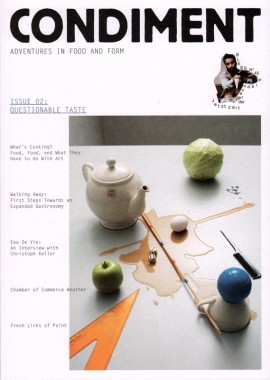
Condiment 2, Questionable Taste
Softcover, 90 pp., offset 4/4, 165 x 230 mm
Edition of 1000
ISSN 1837–8226
Published by Condiment
$18.00 ·
This issue of Condiment has reminded us of the simple truth that we are living with food, not living for food. In this context, the aim shifts from accomplishment to a need for further exploration. Ideas and approaches to food have never seemed so evolved and exaggerated. Yet, as the focus on the meal continues to increase, we risk forgetting about all the hours of living that exist in between. Rather than only being an object of desire, food needs also to be a subject of discussion—approached not as a statement about politics, provenance or proficiency, but as an open-ended question mark. In some form or another, we hope that each page of this issue raises questions —not just about what food is, but about what it can be. After all, each meal is both an outcome and a new beginning.
Produced in collaboration with BLESS. Images from their collection BLESS N° 42, Plädoyer der Jetztzeit appear on each page of the publication.
Amanda Maxwell, Bless, Cameron Allan McKean, Chris Barton, Condiment, Desiree Heiss, Distribution, Elizabeth Bryant, Ellen Birrell, Eva-Fiore Kovacovsky, ffiXXed, Food, Geoff Newton, Ines Kaag, Jessica Brent, Klara Källström, Linus Bill, Misha Hollenbach, Nancy Bale, Riley Payne, Shauna T., Stefan Marx, Taro EF Nettleton, Thobias Fäldt, Thomas Jeppe, Tim J Veling, Uta Eisenreich
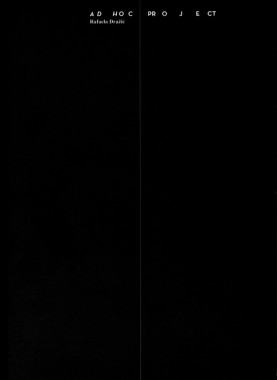
Rafaela Drazic, Ad Hoc Project
Softcover, 140 pp., offset 1/1, 155 x 220 mm
English and Croatian
Edition of 100
Published by Rafaela Drazic
$10.00 ·
Secret Exhibitions project sheds a light on the complicated mechanisms of censorship and destruction within the context of visual arts, which were developed as a part of the processes of post-socialist transformations. The project functions as an interdisciplinary platform of curators, artists, historians and art historians who dealt with the topic of censorship or faced it directly. Project has an emphasized arbitrary nature.
Ana Krsinic Lozica, Distribution, Irena Boric, Ivana Hanacek, Kim Schwenk, Lina Kovacevik, Magdalena Frankowska, Marco Ugolini, Pierre Maite, Rafaela Drazic, Rene Zieger, Robert Canak, Slang International, Slava and Tatars, Stefan Haus, Tomoko Yoneda, Verena Gerlach
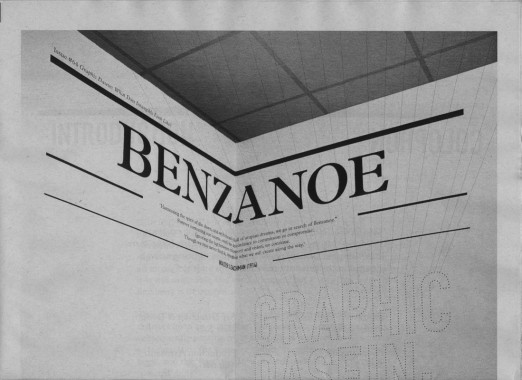
Benzanoe 64, Graphic Dasein*
Newspaper, 12 pp., web offset 1/1, 12.5 x 18 inches
Edition of 100
Published by Benzanoe
$8.00 ·
*
Dasein is the German vernacular term for
existence, it is derived from
da-sein, which literally means
being-there.
“The printed artifact always carries with it belief; under pinned by a historic and cultural relationship between print and truth. Issue 64 deals directly with this concept through a series of install tions, representing the pages of the magazine. The content is delivered through playing with perspective, perception, resolution, view point and production.“
Anders Ekblom, Bryan Clark, Design, Dion Star, Distribution, Dry Carolyn Shapiro, Lizzie Ridout, Martin Heidegger, Mat McIvor, Max Stirner, Steve Tanner, Walter Leachman
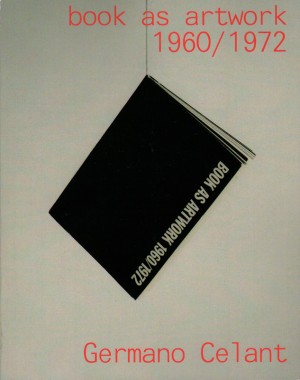
Germano Celant, Book as Artwork 1960-1972
Softcover, 104 pp., offset 1/1, 5.5 x 7 inches
Edition of 800
ISBN 978-0-9829694-0-3
Published by 6 Decades Books
$20.00 ·
Nearly three decades after its first printing,
Book as Artwork 1960-1972 remains a widely-cited landmark in the critical literature on artists’ books. Penned by the critic and curator Germano Celant to accompany an exhibition at Nigel Greenwood Gallery in London, it was the first critical consideration of the artist’s book. A bibliography lists over 300 historic artist-produced publications from this golden age of the medium.
The book is a medium that requires no visual display, other than to be read, and the active mental participation of the reader. The book imposes no information system but the printed image and the word; it is a complete entity in which both public and private documents are reproduced. The book is a collection of photographs, writings, and ideas — it is a product of thought and of imagination. It is a result of concrete activities, and serves to document, and to offer information as the means and the material of art. It is considered an object of study and of testimony and does not appear esoteric or unreal, but fits into the daily communications system without any aesthetic or artistic pretension. It is only another space… and can therefore be considered an art work.
— Germano Celant
6 Decades Books, Art, Art & Project, Charles Harrison, Daniel Templon, DAP, Filippo Passigli, Franco Toselli, Germano Celant, Gian Enzo Sperone, Heiner Friedrich, Ileana Sonnabend, Jorge Glusberg, Konrad Fischer, Leo Castelli, Lisson Gallery, Lynda Morris, Michael Sonnabend, Nigel Greenwood Gallery, Paul Maenz, Situation Gallery, Walther König
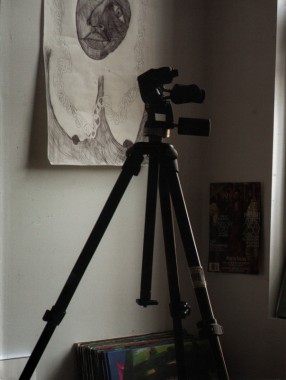
Asher Penn, Nothing Nothing Nothing Nothing 2004-2007
Softcover, 494 pp., offset 4/4, 6.75 x 9 inches
Edition of 1000
ISBN 978-0-982100-60-8
Published by An Art Service
$35.00 ·
In the style of Wolfgang Tillmans and Roe Ethridge, New York-based Asher Penn, born in Vancouver in 1982, captures the quotidian. As an anthology of artist books self-published by Asher Penn between 2004 and 2007 — an anthology that is effectively an artist book itself. Made between Providence, New York, Philadelphia and Vancouver, these ‘zine-like publications are rephotographed page by page on top of painted works that Penn was producing at the time of their re-publication. In rephotographing these original editions on the surface of recent work, Penn cleverly illustrates the creative vertigo capable of creeping up on artists while they look back at the artist that they have become. The artist books collected in this anthology include the following: 1. Just Say Maybe; 2. Go Fuck Yourself With Your Atomic Bomb; 3. Bad Hound, Buddha; 4. School; 5. Asher Mixtape Hell; 6. Elisa Penn Hero One; 7. Institutional Critique; 8. The Heart Wants What The Heart Wants; 9. Before And After; and 10. (Untitled).
An Art Service, Art, Asher Penn, Brendan Dugan, Culture, DAP, Photography, Richard Prince, Roe Ethridge, Wolfgang Tillmans
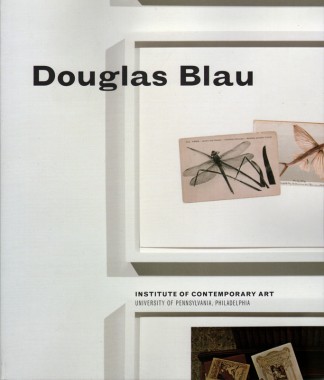
Ingrid Schaffner, Douglas Blau
Softcover, 88 pp., offset 4/4, 8.5 x 10 inches
Edition of 2000
ISBN 978-0-884541-15-8
Published by the Institute of Contemporary Art
$30.00 ·
Douglas Blau, who originally emerged as a critic and curator in tandem with the Pictures Generation, offers up a series of picture epics and episodes from uniformly framed collages of printed matter like postcards, film stills, images of paintings and photographs. Pictures of all kinds are cut and pasted into individual collage elements.
Aaron Igler, Art, Claudia Gould, DAP, Douglas Blau, Henk van Assen, Ingrid Schaffner, Institute of Contemporary Art, Jenelle Porter, Kate Kraczon, Photography
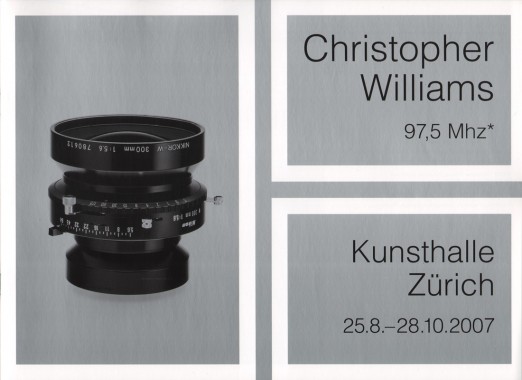
Christopher Williams, 97,5 Mhz
Softcover, 24 pp., offset 4/1, 320 x 235 mm
Edition of 1000
ISBN 978-3-905829-04-4
Published by JRP|Ringier
$25.00 ·
Los Angeles conceptualist Christopher Williams, born in 1956, studies the conditions of presentation and representation in order to call into question spoon-fed perceptions, “realistic” reproductions, communication mechanisms and aesthetic conventions that influence our perception and understanding of reality. This volume presents works from 2003-2007.
Art, Beatrix Ruf, Christopher Williams, DAP, Gudrun Meier, JRP|Ringier, Katharina Pilz, Kunsthalle Zürich, Photography, Rahel Blattler, Yvonne Quirmbach
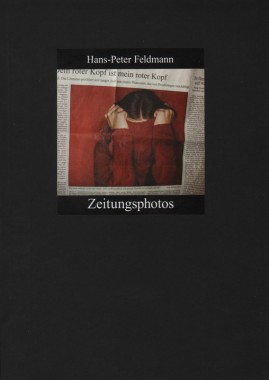
Hans-Peter Feldmann, Zeitungsphotos
Softcover, 48 pp., offset 4/4, 150 x 210 mm
Edition of 2000
ISBN 978-3865601-77-3
Published by Walther König
$22.00 ·
Hans-Peter Feldmann’s idiosyncratic field research investigates the momentum of human perception and the processing of images. This tight collection includes found images of an erupting volcano, a red-eyed ape, a competitive swimmer and celebrity shoes, among others–all taken from journalistic sources.
Art, DAP, Hans-Peter Feldmann, Norbert Schmalen, Photography, Walther König
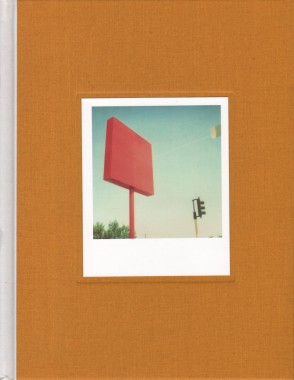
Mike Slack, Ok Ok Ok
Hardcover, 80 pp., offset 4/4, 7 x 9 inches
Second edition
ISBN 978-09776481-2-2
Published by The Ice Plant
$30.00 ·
A series of beautifully composed Polaroids taken by Mike Slack into a wordless trip around the country. Sequenced like a dream, the nameless places and close-up abstractions are anchored to no narrative, but relate to each other through their use of color. They belong to a different time, or maybe a different world.
— Printed Matter
DAP, Louis Pasteur, Mike Slack, Photography, The Ice Plant
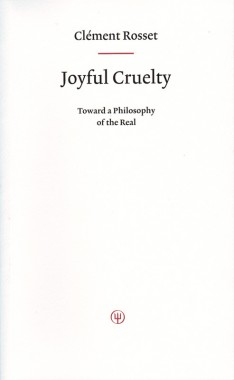
Clément Rosset, Joyful Cruelty: Toward a Philosophy of the Real
Softcover, 160 pp., offset 2/2, 5 x 8 inches
Edition of 1000
ISBN 978-0-9796121-1-4
Published by Free Association
$25.00 ·
This classic collection of essays by French philosopher and essayist Clément Rosset follows another Free Association title in the same format, Werner Herzog’s travel journal, Of Walking on Ice. The publisher is dedicated to finding worthy essays and other texts that have either been out of print or were never made available in English — especially seeking out works that have remained popular, at least among a small, devoted group, over the years. This work, out of print for 20 years, is the first and only work by the Paris-based Rosset (born 1939) to be translated into English. Rosset has written some 30 short books, many of which reference his important influence, Schopenhauer. “Joy is the necessary condition,” writes Rosset, “if not of life in general at least of life lived consciously and with full awareness.”
Clement Rosset, Free Association, Harsh Patel, RAM, Theory












